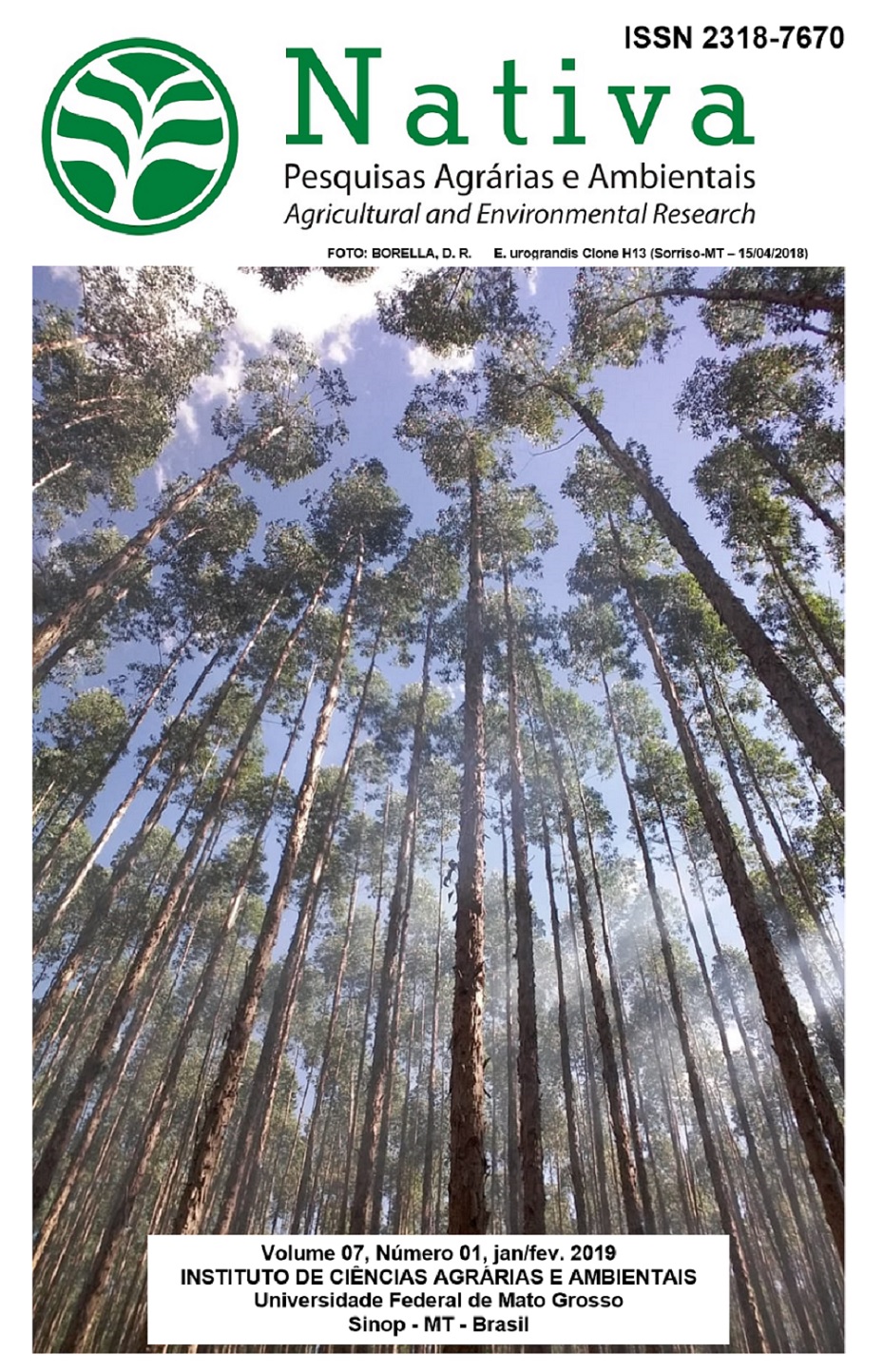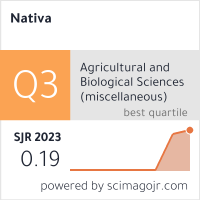EFEITO DE HERBICIDAS NO CRESCIMENTO INICIAL DO SORGO SACARINO
DOI:
https://doi.org/10.31413/nativa.v7i1.6441Resumo
A presença de plantas daninhas pode reduzir severamente o rendimento do sorgo sacarino (Sorghum bicolor), e em função do reduzido número de herbicidas registrados, o objetivo do trabalho foi avaliar o efeito de herbicidas no crescimento inicial dessa cultura. O delineamento experimental foi inteiramente casualizado com cinco repetições, sendo o haloxyfop-methyl, cyhalofop-butil, fomesafem, imazaquim, lactofen, atrazine, 2,4-D e saflufenacil aplicados em diferentes doses em pós-emergência inicial da cultura e os herbicidas atrazine, atrazine+simazine, hexazinone e s-metolachlor em pré-emergência da cultura. As avaliações de fitointoxicação foram realizadas aos 7, 14, 21 e 30 dias após a aplicação (DAT) e a biomassa seca da parte aérea avaliada aos 30 DAT. Em pós-emergência, os herbicidas haloxyfop-methyl e imazaquim provocaram alta fitointoxicação e impactos na biomassa das plantas. 2,4-D e atrazine não provocaram diferenças significativas com relação à testemunha tanto em fitointoxicação como na biomassa. O herbicida lactofen provocou baixa fitointoxicação, todavia, saflufenacil e fomesafen promoveram fitointoxicação na dose comercial próximo a 40% e alterações na biomassa. Dos herbicidas utilizados em pré-emergência, apenas hexazinone e s-metolachlor demonstraram fitointoxicação e alterações na biomassa. Conclui-se que os herbicidas atrazine, lactofen e 2,4-D podem ser utilizados em aplicações em pós-emergência, e atrazine e atrazine+simazine em pré-emergência.
Palavras-chave: fitointoxicação, Sorghum bicolor, pré-emergente, pós-emergente.
EFFECT OF HERBICIDES ON THE INITIAL GROWTH OF SWEET SORGHUM
ABSTRACT:
The presence of weeds may severely reduce yield of sweet sorghum (Sorghum bicolor), and due to the reduced number of herbicides registered, the objective of this work was to evaluate the effect of herbicides on the initial growth of this crop. The experimental design was completely randomized with five replicate, being, the herbicides haloxyfop-methyl, cyhalofop-butyl, fomesafem, imazaquim, lactofen, atrazine, 2,4-D and saflufenacil were applied at different initial post-emergence rates and herbicides atrazine, atrazine + simazine, hexazinone and s- metolachlor in pre-emergence of the culture. The phytointoxication evaluations were performed at 7, 14, 21 and 30 days after application (DAT) and the dry biomass of the aerial part evaluated at 30 DAT. In post-emergence, the herbicides haloxyfop-methyl and imazaquim caused high phytointoxication and impacts on plant biomass. 2,4-D and atrazine did not cause significant differences in relation to the control in both phytointoxication and biomass. The herbicide lactofen caused low phytointoxication, however, saflufenacil and fomesafen promoted phytointoxication at commercial dose close to 40% and changes in biomass. Of the herbicides used in pre-emergence, only hexazinone and s-metolachlor demonstrated phytointoxication and changes in biomass. It is concluded that the herbicides atrazine, lactofen and 2,4-D can be used in post-emergence applications, and pre-emergence atrazine and atrazine + simazine.
Keywords: phytointoxication, Sorghum bicolor, pre-emergent, post-emergent.
Referências
ARCHANGELO, E. R.; SILVA, A. A.; SILVA, J. B.; KARAM, D. Seletividade e eficácia de herbicidas aplicados em pós-emergência na cultura do sorgo forrageiro. Revista Brasileira de Milho e Sorgo, Sete Lagoas, v.1, n.3, p.107-115, 2002. DOI: http://dx.doi.org/10.18512/1980-6477/rbms.v1n03p%25p
BURKE, I. C.; THOMAS, W.E.; BURTON, J.D.; SPEARS J.F.; WILCUT J.W. A seedling assay to screen aryloxyphenoxypropionic acid and cyclohexanedione resistance in johnsongrass (Sorghum halepense). Weed Technology, Faytteville, v. 20, n. 4, p. 950-955, 2006. DOI: https://dx.doi.org/10.1614/WT-05-160.1
CONCENÇO, G., ANDRES, A., CECCON, G. Manejo de plantas daninhas na cultura do sorgo sacarino. 1. ed. Embrapa Agropecuária Oeste, 2012. 5 p. (Comunicado Técnico, 2004)
CORREIA, N. M.; GOMES, L. J. P. Selectivity of saflufenacil for sweet sorghum and potential use of Na-Bentazon as a Safener. Planta Daninha. Viçosa, v. 33, p. 267-274, 2015. DOI: http://dx.doi.org/10.1590/0100-83582015000200012
DAN, H. A.; DAN, L. G. M.; BARROSO, A. L. L.; OLIVEIRA JR. R. S.; GUERRA, N.; FELDKIRCHER, C. Tolerância do sorgo granífero ao 2,4-D aplicado em pós-emergência. Planta Daninha, Viçosa, v. 28, p. 785-792, 2010. DOI: http://dx.doi.org/10.1590/S0100-83582010000400011
FROMME, D. D.; DOTRAY, P. A.; GRICHAR, W. J.; FERNANDEZ, C. J. Weed control and grain sorghum (Sorghum bicolor) tolerance to pyrasulfotole plus bromoxynil. International Journal of Agronomy, Davis, v. 2012, p. 1-10, 2012. DOI: http://dx.doi.org/10.1155/2012/951454
GALON, L.; FERNANDES, F. F.; ANDRES, A.; SILVA, A. F.; FORTE, C. T. Selectivity and efficiency of herbicides in weed control on sweet sorghum. Pesquisa Agropecuária Tropical, v. 46, n. 2, p. 123-131, 2016. DOI: http://dx.doi.org/10.1590/1983-40632016v4639431
GIACOMINI, I.; PEDROZA, M. M.; SIQUEIRA, F. L. T.; MELLO, S. Q. S.; CERQUEIRA, F. B.; SALLA, L. Uso potencial de sorgo sacarino para a produção de etanol no estado do Tocantins. Revista Agrogeoambiental, Pouso Alegre, v. 5, n. 3, p. 73-83, 2013. http://dx.doi.org/10.18406/2316-1817v5n32013531
INOUE, M. H.; MARCHIORI JR., O.; OLIVEIRA JR., R. S.; CONSTANTIN, J.; TORMENA, C. A. Calagem e o potencial de lixiviação de imazaquin em colunas de solo. Planta Daninha, Viçosa, v. 20, n. 1, p. 125-132, abr. 2002. DOI: http://dx.doi.org/10.1590/S0100-83582002000100016
KAAPRO, J.; HALL, J. Indaziflam, a new herbicide for pre-emergent control of weeds in turf, forestry, industrial vegetation and ornamentals. Pakistan Journal of Weed Science Research, Peshawar, v. 18, p. 267-270, 2012.
MITCHELL, G. D. W.; BARTLETT, D. W.; FRASER, T. E, HAWKES, T. R.; HOLT, D. C; TOWNSON, J. K.; WICHERT, R. A. Mesotrione: A new selective herbicide for use in maize. Pest Management Science, v. 57, p. 120-128, 2011. DOI: https://dx.doi.org/10.1002/1526-4998(200102)57:2%3C120::AID-PS254%3E3.0.CO;2-E
MYERS, D. F.; HANRAHAN, R.; MICHEL, J.; MONKE, B.; MUDGE, L. Indaziflam/BCS AA170717 a new herbicide for preemergent control of grasses and broadleaves in turf and ornamentals. Proceedings - Southern Weed Science Society, Westminster, v. 62, p. 393, 2009.
PETTER, F. A.; PACHECO, L. P.; ALCÂNTARA NETO, F.; ZUFFO, A. M.; PROCÓPIO, S. O.; ALMEIDA, F. A. Desempenho agronômico do sorgo em função de doses e épocas de aplicação do herbicida 2,4-D. Planta Daninha, Viçosa, v. 29, n. esp., p. 1091-1098, 2011. DOI: http://dx.doi.org/10.1590/S0100-83582011000500016
RODRIGUES, A. C. P.; COSTA, N. V.; CARDOSO, L. A.; CAMPOS, C. F.; MARTINS, D. Períodos de interferência de plantas daninhas na cultura do sorgo. Planta Daninha, Viçosa, v. 28, n. 1, p. 23-31, 2010. DOI: http://dx.doi.org/10.1590/S0100-83582010000100003
RODRIGUES, B. N.; ALMEIDA, F. S. Guia de herbicidas. 6. ed. Londrina: IAPAR, 2015. 697 p.
ROSALES-ROBLES, E.; SANCHEZ-DE-LA-CRUZ, R.; RODRIGUEZ-DEL-BOSQUE, L. A. Tolerância de sorgo para grano a los herbicidas. Revista fitotecnia mexicana, Chapingo, v. 37, p. 89-94, mar. 2014.
SANTOS, J. G. M. Controle químico de plantas daninhas na cultura do feijão (Phaseolus vulgaris L.), no inverno. 1991. 86f. Dissertação (Mestrado em Fitotecnia) – Universidade Federal de Viçosa, 1991.
SILVA, J. B. da; PASSINI, T.; VIANA, A. C. Controle de plantas daninhas na cultura do sorgo. Informe Agropecuário, v. 12, n. 144, p. 43-45, 1986.
SHAW, D. R.; ARNOLD, J. C. Weed control from herbicide combinations with glyphosate. Weed Technology, Faytteville, v. 16, n. 1, p. 1-6, 2002. DOI: https://dx.doi.org/10.1614/0890-037X(2002)016[0001:WCFHCW]2.0.CO;2
TAMADO, T.; MILBERG, P. Control of Parthenium (Parthenium hysterophorus) in Grain Sorghum (Sorghum bicolor) in the Smallholder Farming System in Eastern Ethiopia1. Weed Technology, v. 18, p.100-105, jan. 2004. DOI: http://dx.doi.org/10.1614/WT-03-033R
TAMADO, T.; SCHUTZ, W.; MILBERG, P. Germination ecology of the weed Parthenium hysterophorus in eastern Ethiopia. Annals Applied Biology, Newport, v. 140, n. 2, p. 263-270, 2002. DOI: https://dx.doi.org/10.1111/j.1744-7348.2002.tb00180.x
Downloads
Publicado
Edição
Seção
Como Citar
Licença
Direitos Autorais para artigos publicados nesta revista são do autor, com direitos de primeira publicação para a revista. Em virtude de a aparecerem nesta revista de acesso público, os artigos são de uso gratuito, com atribuições próprias, em aplicações educacionais e não-comerciais.
A artigos publicados nessa revista, podem ser reproduzidos parcialmente ou utilizados como referência por outros autores, desde que seja cita a fonte, ou seja, a Revista Nativa.
Copyright for articles published in this journal are the authors, with first publication rights granted to the journal. The journal shows open access, and articles are free to use, with proper attribution, in educational and non-commercial.
The articles published in this journal may be reproduced in part or used as a reference by other authors, provided that the source is quoted.






